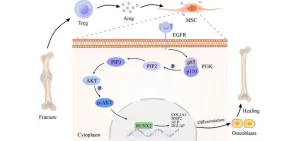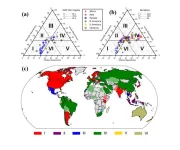(Press-News.org) London, UK, 30 August 2024: The 2024 ESC Guidelines for the management of peripheral arterial and aortic diseases (PAAD) evaluate these vascular diseases together as part of same cardiovascular system, appreciating that patients with aortic diseases are at risk of having peripheral vascular diseases and vice versa. The Guidelines are aimed at cardiologists, but were coordinated for alignment with guidelines for surgeons by EACTS and endorsed by VASCERN and ESVM.
“These updated guidelines have been introduced now due to significant advancements and shifts in our understanding and management of aortic and peripheral artery diseases (PAD), including new treatment modalities, since the last guidelines were published in 2014 and 2017, respectively,” says ESC Guidelines co-chair Professor Jose Fernando Rodriguez Palomares, University Hospital Vall d'Hebron, Barcelona, Spain.
“The decision to integrate these guidelines is based on several key factors. The aorta and peripheral arteries are integral components of the same arterial system. Disorders in one part of this system often have implications for the other,” adds co-chair Professor Lucia Mazzolai of Lausanne University Hospital, Switzerland. “Combining the guidelines provides consistent and standardised recommendations for the management of arterial diseases as a whole. This ensures that patients receive cohesive and coordinated care across different vascular conditions, reducing fragmentation and improving overall treatment outcomes.”
PAAD is estimated to affect around 113 million people aged 40 and over globally, of whom nearly half (43%) are in low- and middle-income countries. The global prevalence is 1.5% and increases with age, affecting 15-20% of those aged 70 years and over and 20-30% of those aged 80 years and older. Prevalence increased by 72% from 1990 to 2019, despite the global population growing only 45%.
PAD is a common circulatory problem in which narrowed arteries reduce blood flow to the limbs, more frequently the legs. It is primarily caused by atherosclerosis, where fatty deposits build up on the artery walls. “This condition can lead to a range of symptoms and complications, significantly affecting both patients and their families,” explains Prof Mazzolai. “Disease manifests in patients with pain, cramping, or fatigue in the legs during physical activity, which subsides with rest. This induces mobility issues affecting daily tasks and quality of life. If not well treated the disease can evolve to severe forms of PAD potentially leading to pain present at rest, non-healing ulcers and risk of amputation. Moreover, presence of PAD significantly increases the risk of cardiac and cerebral events.”
“The burden such diseases place on families is substantial, with patients requiring support in all sorts of ways including the activities of daily life. The whole family may need to adopt lifestyle changes to support the patient, such as healthier eating and exercise,” explains Professor Rodriguez Palomares.
The authors say the most important recommendations in the new 2024 Guidelines are those addressing the chronic nature of PAAD, the importance of screening, and the necessity of comprehensive treatment strategies – and awareness that this a chronic disease that needs lifetime follow-up.
“A significant proportion of patients are asymptomatic and therefore PAAD screening is crucial, based on age, the presence of cardiovascular risk factors, family history and/or presence of syndromic features. PAAD diagnosis can be easily achieved with a non-interventional vascular test/imaging,” says Professor Rodriguez Palomares. The guidelines highlight that optimal pharmacological treatment (antithrombotic, lipid-lowering, antihypertensive, antidiabetic) and emphasis on exercise and lifestyle changes are mandatory and effective in reducing burden of disease. Patients with PAAD have a very high cardiovascular risk and require optimal management of risk factors such as hypertension, hyperlipidemia, and diabetes to prevent serious complications.
Finally, the authors emphasise gender aspects and that PAAD comprises chronic diseases requiring continued attention. They conclude: “PAAD is a chronic disease necessitating lifelong follow-up by vascular specialists, cardiologists, and a multidisciplinary team. Women often present with atypical or asymptomatic disease, warranting special attention during screening. Exercise and lifestyle changes are crucial before considering interventional management in chronic PAAD.”
ENDS
Disclosures: Please see full guidelines for all disclosures.
References and notes
The ‘2024 ESC Guidelines for the management of peripheral arterial and aortic diseases’ will be discussed during the session “2024 ESC Guidelines overview”, Friday 30 August at 8:15am BST in room London.
2024 ESC Guidelines for the management of peripheral arterial and aortic diseases, European Heart Journal, 2024, https://doi.org/10.1093/eurheartj/ehae179
ESC Press Office
Tel: +33 6 61 40 18 84
Email: press@escardio.org
The hashtag for ESC Congress 2024 is #ESCCongress
Follow us on X @ESCardioNews
Journalists are invited to become accredited and register here.
Check out the ESC Media and Embargo Policy.
About ESC Congress 2024
It is the world’s largest gathering of cardiovascular professionals, disseminating ground-breaking science both onsite in London and online – from 30 August to 2 September. Explore the scientific programme. More information is available from the ESC Press Office at press@escardio.org.
About the European Society of Cardiology
The European Society of Cardiology brings together health care professionals from more than 150 countries, working to advance cardiovascular medicine and help people lead longer, healthier lives.
END
New ESC Guidelines combine peripheral arterial and aortic diseases for first time, emphasising interconnectivity of whole arterial system
2024-08-30
ELSE PRESS RELEASES FROM THIS DATE:
New Chronic Coronary Syndrome (CCS) Guidelines expand diagnostic tools and ways to prevent major adverse events and enhance quality of life
2024-08-30
London, UK, 30 August 2024: The 2024 ESC Guidelines on the management of chronic coronary syndromes (CCS) include a focus on both larger and smaller blood vessels of the heart; new models to estimate chances of blocked large arteries (so-called obstructive coronary artery disease); optimal selection and sequence of tests; drugs and interventions to prevent disease complications and improve symptoms, and the fundamental role of patient involvement.
“The new guidelines prompt cardiologists to rethink chronic coronary syndromes ...
Atrial fibrillation guidelines focus on shared and equal care, patient empowerment, comorbidities, evidence-based management and dynamic re-evaluation
2024-08-30
London, UK, 30 August 2024: The 2024 ESC Guidelines for the management of atrial fibrillation, developed in collaboration with the European Association of Cardio-Thoracic Surgery (EACTS), contain a number of new approaches and treatment-specific recommendations to help manage the surging numbers of patients with AF worldwide.
“Atrial fibrillation (AF) is one of the most commonly encountered heart conditions, with a broad impact on all health services across primary, secondary and tertiary care,” says Guidelines Chair Professor Isabelle C. Van Gelder, University Medical Centre Groningen, Groningen, The Netherlands. “The prevalence ...
Two thirds of deaths related to high BMI are due to cardiovascular diseases - ESC Clinical Consensus Statement on Obesity and Cardiovascular Disease
2024-08-30
London, United Kingdom – 30 August 2024: The ESC Clinical Consensus Statement on Obesity and Cardiovascular Disease, presented at this year’s ESC Congress (London, UK, 30 August to 2 September) summarises current evidence on the epidemiology and aetiology of obesity; the interplay between obesity, cardiovascular risk factors and cardiac conditions; the clinical management of patients with cardiac disease and obesity; and weight loss strategies including lifestyle changes, interventional procedures, and anti-obesity medications with particular focus ...
Prehospital pulse-dose glucocorticoid in ST-segment elevation myocardial infarction
2024-08-30
About The Study: In patients with ST-segment elevation myocardial infarction, treatment with prehospital pulse-dose glucocorticoid did not reduce final infarct size after 3 months. However, the trial was likely underpowered as the final infarct size was smaller than anticipated. The glucocorticoid group had improved acute parameters compared with placebo.
Corresponding Author: To contact the corresponding author, Jasmine Melissa Madsen, MD, email jasmine.melissa.madsen.01@regionh.dk.
To access the embargoed study: Visit our For The Media website at this link https://media.jamanetwork.com/
(doi:10.1001/jamacardio.2024.2298)
Editor’s ...
Effects of sacubitril/valsartan on all-cause hospitalizations in heart failure
2024-08-30
About The Study: In this post hoc pooled analysis of 13,194 patients with chronic heart failure (HF) in the PARADIGM-HF and PARAGON-HF randomized clinical trials, sacubitril/valsartan significantly reduced hospitalization for any reason, with benefits most apparent in patients with a left ventricular ejection fraction below normal. This reduction appeared to be principally driven by lower rates of cardiac and pulmonary hospitalizations.
Corresponding Author: To contact the corresponding author, Muthiah Vaduganathan, MD, MPH, email mvaduganathan@bwh.harvard.edu.
To ...
Promising antibiotic candidates discovered in microbes deep in the Arctic Sea
2024-08-30
Antibiotics are the linchpin of modern medicine: without them, anyone with open wounds or needing to undergo surgery would be at constant risk of dangerous infections. Yet we continue to face a global antibiotics crisis, as more and more resistant strains of bacteria are evolving, while the rate of discovery of fundamentally new antibiotics has been much slower.
But there is reason for hope: 70% of all currently licensed antibiotics have been derived from actinobacteria in the soil, and most environments on Earth have not yet ...
A distinct “repair” role of regulatory T cells in fracture healing
2024-08-30
The study uncovers a unique reparative function of regulatory T cells (Tregs) in the process of fracture healing, a discovery that adds a new dimension to our understanding of the immune response in tissue regeneration. Tregs, a subset of T cells known for their role in maintaining immune tolerance and preventing autoimmunity, are now shown to play a critical part in the intricate interplay between the immune system and bone repair.
Fracture healing is a complex process that involves a sequence of events, including inflammation, repair, and remodeling. While the initial ...
Dancing galaxies make a monster at the cosmic dawn
2024-08-30
Astronomers have spotted a pair of galaxies in the act of merging 12.8 billion years ago. The characteristics of these galaxies indicate that the merger will form a monster galaxy, one of the brightest types of objects in the Universe. These results are important for understanding the early evolution of galaxies and black holes in the early Universe.
Quasars are bright objects powered by matter falling into a supermassive black hole at the center of a galaxy in the early Universe. The most accepted theory is that when two gas-rich galaxies merge to form a single larger galaxy, the gravitational interaction of the two galaxies causes gas to fall towards the supermassive ...
Drought risk and awareness gaps in global society
2024-08-30
Natural disasters have threatened to human beings and the ecosystem. Among the various natural disasters, drought is one of the most insidious and costliest, adversely affecting the global economy and livelihoods. Unlike sudden disasters such as earthquakes or hurricanes, drought is a slow-onset phenomenon that gradually intensifies. This prolonged nature of drought often results in the shortage of drinking water and the disruption of local economies.
The Slow Onset and Impact of Drought
Drought creeps in gradually, often going unnoticed until it reaches a critical stage. This slow progression makes drought particularly challenging to manage and mitigate. Initially, ...
UAF scientist’s method could give months’ warning of major earthquakes
2024-08-30
The public could have days or months of warning about a major earthquake through identification of prior low-level tectonic unrest over large areas, according to research by a University of Alaska Fairbanks scientist who analyzed two major quakes in Alaska and California.
The work was led by research assistant professor Társilo Girona of the UAF Geophysical Institute.
Girona, a geophysicist and data scientist, studies precursory activity of volcanic eruptions and earthquakes. Geologist Kyriaki Drymoni of the Ludwig-Maximilians-Universität in Munich, Germany, is a co-author.
The ...



